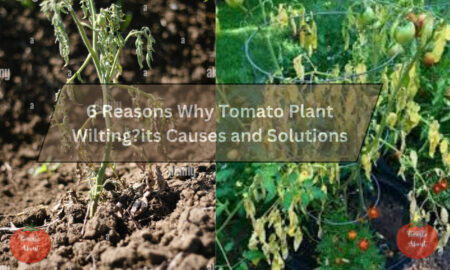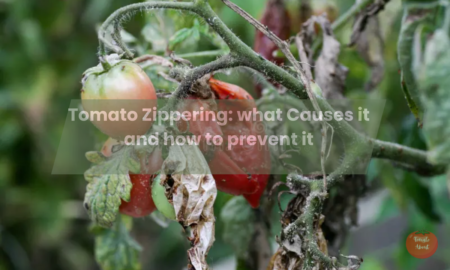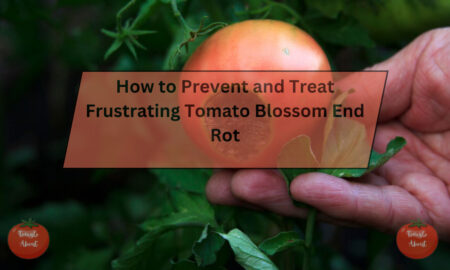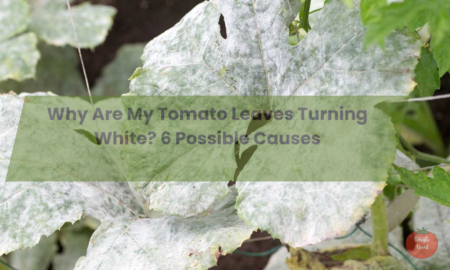Caterpillars can cause a lot of damage in vegetable gardens by eating the leaves and fruit of plants like tomatoes. Most gardeners want to get rid of these hungry caterpillars before they ruin the plants.
Many different kinds of caterpillars will eat both the leaves and fruit of garden plants. You may first notice little black droppings from the caterpillars on the leaves below where they are eating. Looking closely at the plants, you will see the caterpillars and the damage they have done.
Some caterpillars are green so they blend in well with the green leaves of the plants. Others hide under leaves during the day and only come out to eat at night. When you see a caterpillar, notice its color, patterns, shape, and size to help identify it.
Once you know what kind of caterpillar it is, you can look up information on how to control that specific pest in a safe way for your garden. Next, we will talk about some common caterpillar pests found in gardens.
7 Common Tomato Caterpillars(+ how to deal with them).
1.Tomato Hornworm
Easily recognizable by their impressive size and distinctive features, tomato hornworms (Manduca quinquemaculata) are among the most notorious tomato pests. These green caterpillars can grow up to 4-5 inches in length and sport eight white horizontal V-shapes along their sides, each accompanied by a black eye-like marking. Their name is derived from the prominent black horn protruding from their rear end.
Tomato hornworms are voracious eaters, starting their assault on the uppermost leaves before working their way down the plant. They hide under the foliage during the day and feed at night, leaving behind bare stems and a trail of black droppings (frass) on the remaining leaves.
Control Methods:
- Hand-picking: Carefully inspect your plants, especially at night, and remove any hornworms you find. Drop them into soapy water or feed them to your chickens, as they are not poisonous.
- Black light flashlights: Invest in an inexpensive black light flashlight to easily spot the hornworms on your plants after dark.
- Organic pesticides: Apply organic pesticides containing Bacillus thuringiensis (Bt), a bacteria that specifically targets caterpillars. Follow the instructions carefully and reapply after rain.
- Biological control: Encourage parasitic wasps, which lay their eggs inside the hornworms. As the wasp larvae hatch, they feed on the hornworm from the inside, eventually spinning white cocoons on the caterpillar’s body.
2. Tobacco Hornworm
Closely related to the tomato hornworm, the tobacco hornworm (Manduca sexta) is another formidable foe for tomato growers. These caterpillars share a similar green coloration but feature a distinct pattern of seven white stripes along their sides, adorned with black spots. They also have a red horn at their rear end.
Like their cousins, tobacco hornworms feast on the foliage of nightshade plants, including tomatoes, potatoes, eggplants, and peppers. They can quickly strip plants of their leaves and even damage green tomatoes, creating entry points for other pests and diseases.
Control Methods:
The control methods for tobacco hornworms are similar to those for tomato hornworms:
- Hand-picking and removal
- Organic pesticides containing Bacillus thuringiensis (Bt)
- Encouraging natural predators like parasitic wasps
3. Yellow-striped Armyworm
The name “armyworm” aptly describes the destructive potential of these caterpillars, which can quickly overwhelm your tomato plants with their sheer numbers. The yellow-striped armyworm (Spodoptera ornithogalli) is easily identified by its distinctive yellow stripe running along the sides of its dark-colored body, accompanied by brown stripes and a dark spot at the rear.
These caterpillars, part of the Noctuidae family of moths, have a wide host range and can attack various crops and ornamentals. They are active from mid-spring to late autumn, with the females laying up to 500 eggs at a time, hatching within just 3-5 days.
Once established, armyworms can rapidly defoliate tomato plants, feeding on the foliage and damaging the fruit. Their numbers can quickly spiral out of control, making early detection and intervention crucial.
Control Methods:
- Organic insecticides: Apply organic insecticides containing Bacillus thuringiensis (Bt) at the first sign of infestation, following the instructions carefully.
- Weed control: Maintain a weed-free environment, as armyworms often migrate from nearby weeds to your crops.
- Natural predators: Encourage beneficial insects like ladybugs, lacewings, and parasitic wasps, which can help control armyworm populations.
4. Beet Armyworm
While the name might suggest a preference for beets, the beet armyworm (Spodoptera exigua) is a generalist pest that can also attack tomato plants, particularly later in the growing season. These pale green to yellow caterpillars, adorned with stripes and dark dashes along their sides, grow to just under an inch in length.
Beet armyworms are known for their agility, leaving behind strands of silk as they move from plant to plant. They target buds, new growth, and can quickly decimate young tomato plants. Their nocturnal habits make them challenging to detect during the day.
Control Methods:
- Early detection: Regularly inspect your plants, especially early in the season, for signs of damage or the presence of caterpillars.
- Manual removal: Pick off any caterpillars you find and drop them into soapy water.
- Pheromone traps: Use pheromone traps to monitor and reduce the adult moth population, thereby reducing egg-laying.
- Biological controls: Explore the use of beneficial nematodes or Bacillus thuringiensis (Bt) products specifically formulated for beet armyworms.
- Neem oil: Apply neem oil, a natural insecticide derived from the neem tree, which can effectively control beet armyworms.
5. Fall Armyworm
As the name implies, the fall armyworm (Spodoptera frugiperda) is a late-season pest, becoming active in late summer and continuing into the fall months. In warmer regions, these caterpillars may even persist throughout the winter.
Female fall armyworm moths can lay an astonishing 2,000 eggs, which hatch into striped caterpillars in various shades of brown, green, and yellow. As they mature, white lines form along their bodies, and a light-colored inverted V appears on their heads.
These voracious feeders can cause significant damage to tomato plants, burrowing deeply into the fruit and causing rot. Their wide host range, encompassing hundreds of plant species, makes them a formidable threat to many crops and ornamentals.
Control Methods:
- Pheromone traps: Monitor and reduce adult moth populations using pheromone traps.
- Bacillus thuringiensis (Bt): Apply Bt products specifically formulated for fall armyworms at the first sign of infestation.
- Insecticides: For severe infestations, consider using insecticides specifically labeled for fall armyworm control, following all instructions carefully.
6. Tomato Fruitworm
As the name suggests, the tomato fruitworm (Helicoverpa zea) is a particular menace when it comes to tomato fruit. These nocturnal caterpillars, part of the Noctuidae family, tunnel into developing tomatoes, leaving round entry holes and depositing their droppings along the way.
Tomato fruitworms can vary in color, ranging from brown and cream to yellow, black, and gray, with stripes running along their hairy bodies. They grow to around 1.5-2 inches in length and are known for their cannibalistic tendencies, feeding on other fruitworms that dare to encroach on their territory.
Control Methods:
- Pruning: Remove and destroy any damaged or infested fruit, eliminating potential breeding grounds.
- Bacillus thuringiensis (Bt): Apply Bt products specifically formulated for fruitworms, as they must ingest the bacteria for it to be effective.
- Diatomaceous earth: Dust plants with diatomaceous earth, a natural insecticide that damages the caterpillars’ exoskeletons.
- Parasitic wasps: Encourage parasitic wasps, which can help control fruitworm populations by laying their eggs inside the caterpillars.
7. Tomato Moth Caterpillar
The tomato moth (Lacanobia oleracea), also known as the Bright-line Brown-eye, is a member of the Noctuidae family and a lesser-known but still potentially troublesome pest for tomato growers. The moths lay up to 300 eggs on the undersides of leaves, and the caterpillars hatch within a week.
These caterpillars undergo color changes as they mature, starting pale green, then transitioning to mottled gray and brown hues, eventually forming a yellow stripe with black spots along their sides. They begin by feeding on the leaves before burrowing into the fruit, causing significant damage.
While active throughout the summer months, tomato moth caterpillars are most commonly found in greenhouses, where their life cycle can continue uninterrupted by harsh weather conditions.
Control Methods:
- Hand-picking: For small-scale infestations or isolated plants, hand-picking the caterpillars and dropping them into soapy water can be an effective solution.
- Chemical insecticides: For more severe outbreaks, consider using insecticides specifically formulated for caterpillar control, following all instructions carefully.
- Biological controls: Explore the use of beneficial nematodes or Bacillus thuringiensis (Bt) products, which can effectively target tomato moth caterpillars.
Conclusion
Caterpillars can be a significant nuisance for tomato growers, but with proper identification and timely action, their impact can be minimized. By understanding the characteristics and behaviors of these common caterpillars, you can implement targeted control measures and protect your tomato plants from severe damage.
Remember, prevention is key, so consider incorporating cultural practices like crop rotation, companion planting, and removing plant debris to discourage caterpillar infestations. Additionally, encouraging natural predators and using biological controls can help maintain a balanced garden ecosystem while minimizing the need for harsh chemical insecticides.
With diligence and a proactive approach, you can enjoy a bountiful tomato harvest and protect your plants from the voracious appetites of these caterpillar pests. By implementing an Integrated Pest Management strategy, you can create a sustainable and resilient garden that thrives for years to come.






